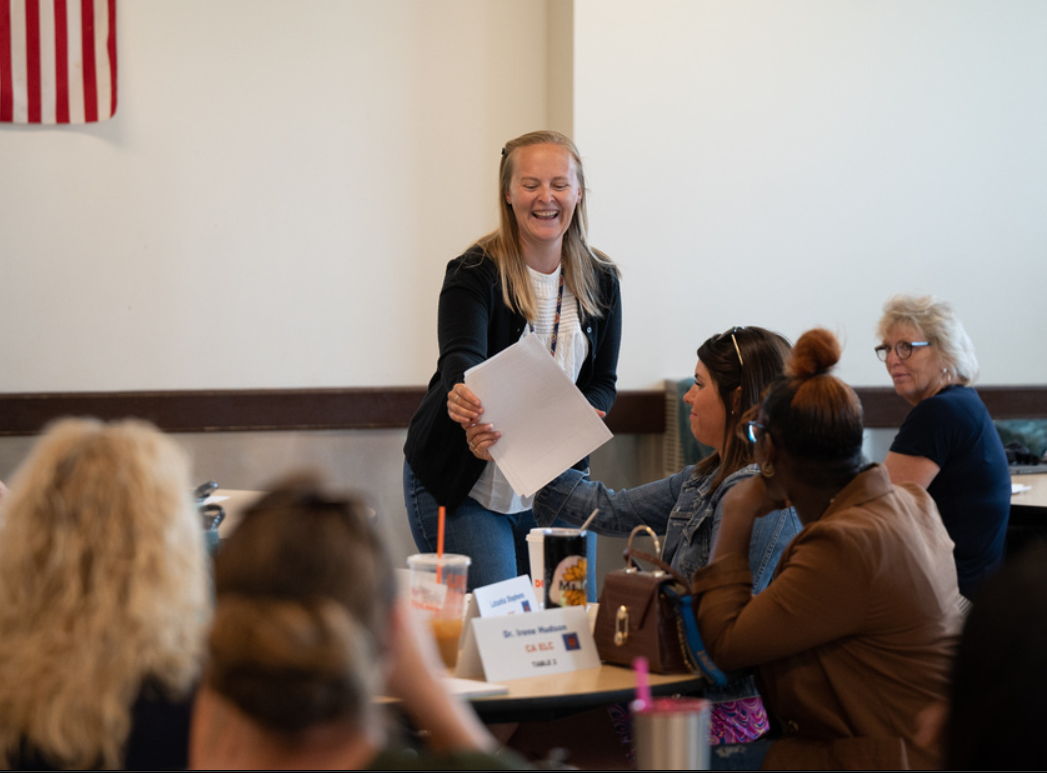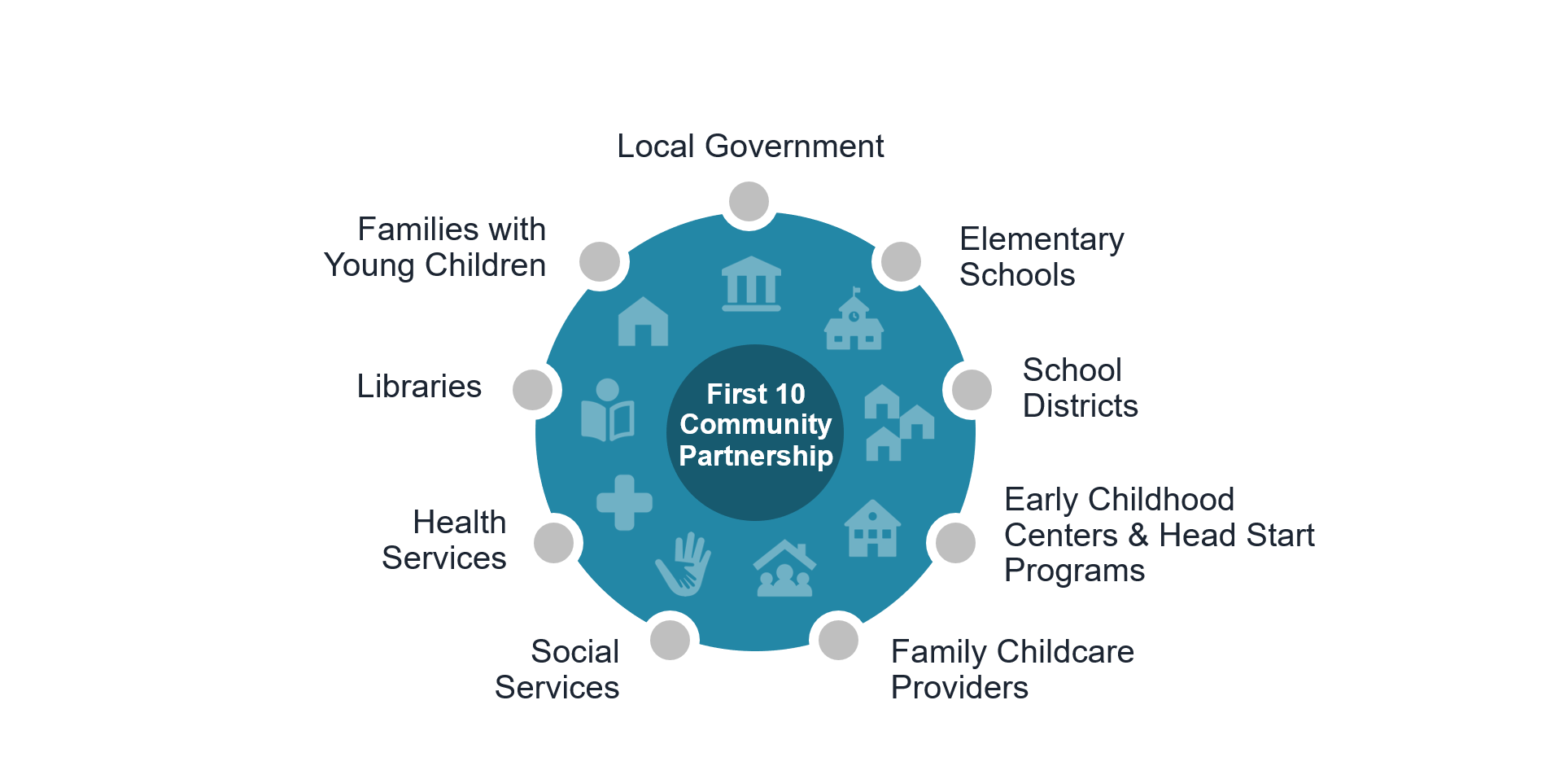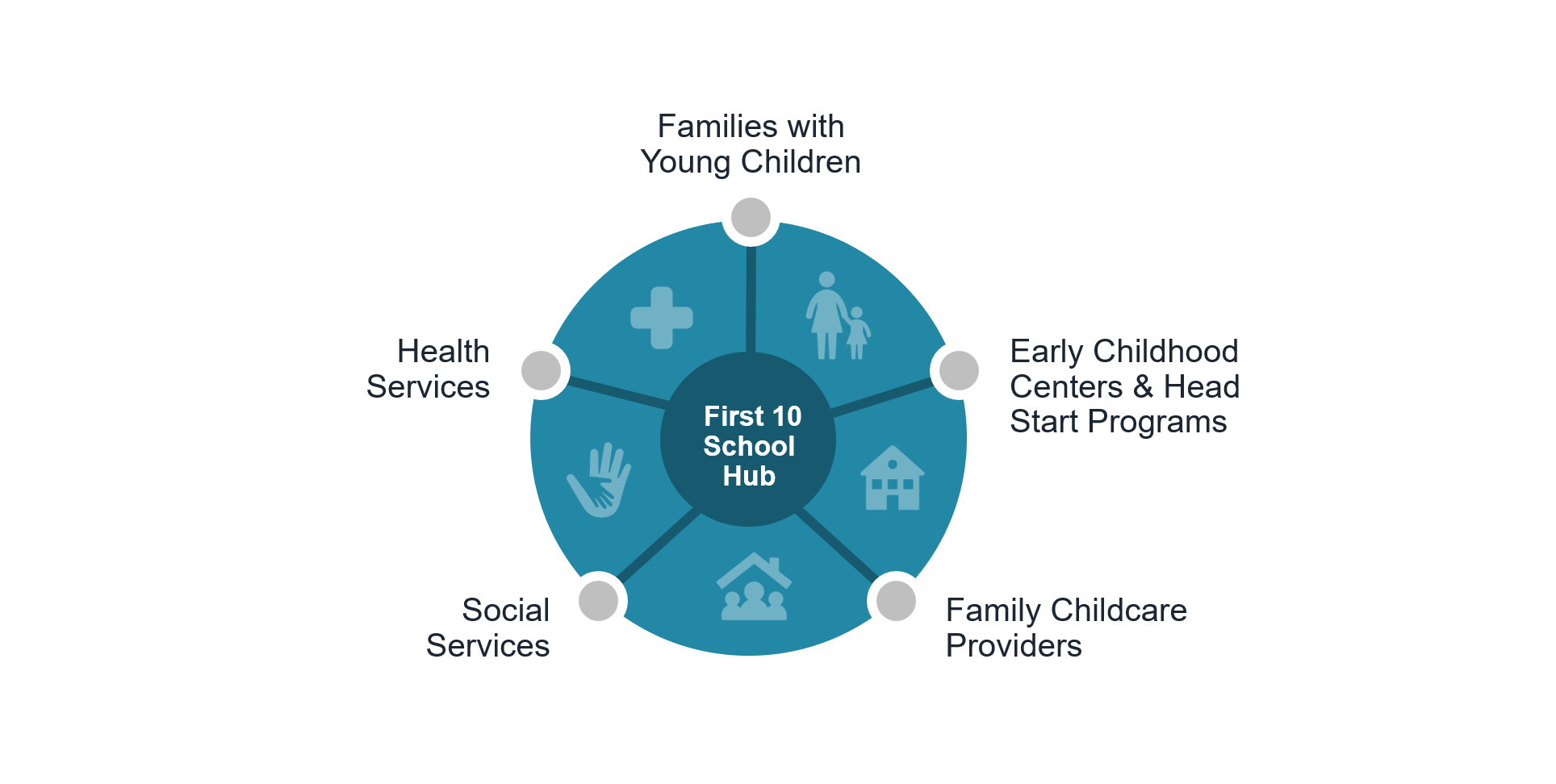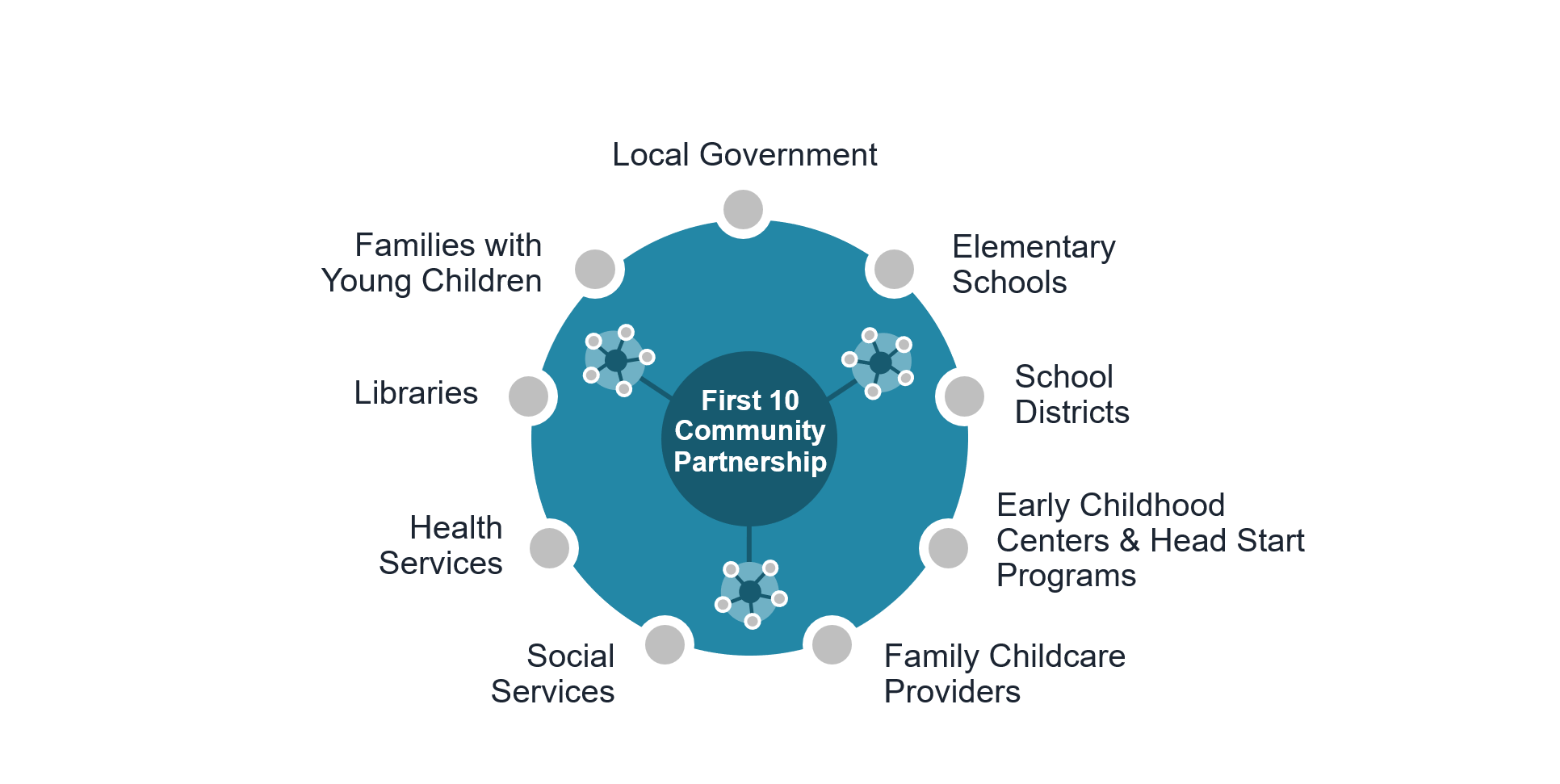
The second post in this series showed how First 10 partnerships are funded, how they are advancing equity by using this funding to support urban and rural communities with significant low-income populations, and how some partnerships are combining First 10 with anti-racism efforts. In this post, I discuss how communities get started with First 10. I describe the two structures—community-wide partnerships and school-based hubs—First 10 partnerships employ to carry out their work, how they form teams, and how they begin their planning efforts.
Community-wide and School-based First 10 Structures, Sometimes in Combination
The First 10 initiative in York City, PA is a good example of a comprehensive First 10 community partnership (see Figure 1 below). York City is a district of approximately 6100 students, 91% are students of color, and 95% are low-income. The First 10 initiative spans the entire city. First 10 is overseen by a steering committee that includes a board member/parent representative and senior leaders from the district, several early childhood programs, the library, local funders, and other nonprofit organizations. York is forming a family advisory committee to allow for more direct community representation, and importantly, the school district is pairing its First 10 work with a major racial equity and cultural competence training push. At the beginning of the pandemic it established several First 10 teams to carry out a number of strategies that impact the entire community:
- Implementing a city-wide transition to kindergarten plan that includes strategies to support children and families throughout the transition, extensive collaboration with the public library, and alignment of teaching and learning across prekindergarten and kindergarten, in part through ongoing joint professional learning among Head Start, prekindergarten (from both community-based and district classrooms), and kindergarten teachers.
- Organizing a series of school-connected play and learns at elementary schools across the city with the goal of establishing good relationships with families with young children, promoting developmentally-appropriate activities, encouraging peer connections, connecting families to peers and community resources, and developing family leaders.
- Promoting two-way partnerships with families and conducting a city-wide parenting campaign using The Basics in which all First 10 partners “saturate the community” with five simple parenting principles.
- Implementing a district-wide early literacy initiative based on the science of reading that includes a new ELA curriculum and extensive professional development as well as, consistent with the transition plan, ongoing prekindergarten-kindergarten teacher collaboration across community-based, Head Start, and district classrooms.

The defining feature of a First 10 community partnership is that it includes two or more elementary schools and all the early childhood programs and family-serving health and social service programs in the area around the schools. Most community partnerships, like York City, are defined by the boundaries of the school district or town/city, but in large cities the partnership might focus on a large neighborhood within the city. Both urban and rural First 10 initiatives can employ the community-wide partnership structure, and I will profile a number of rural community-wide partnerships in the posts that follow. Most but not all First 10 initiatives begin as community partnerships.
Across the Susquehanna River from York in the city of Lancaster, George Washington Elementary School is a good example of a First 10 community school hub. First 10 community school hubs are anchored by a single elementary school, which extends supports to families with young children in its neighborhood/catchment area and partners with nearby early childhood programs and community programs (see Figure 2 below). The exemplar initiatives in Metro Omaha, NE, Multnomah County, OR, and Cincinnati, OH profiled in the All Children Learn and Thrive report all employed the school hub structure.

Washington had been a community school serving as a hub of health and social services for 10 years when it joined with 4 rural communities in Lancaster County to participate in a First 10 initiative led by the county Community Action Partnership (CAP agency) and funded by a United Way collective impact grant.
Washington has made a number of changes as a result of its participation in the First 10 initiative. The school has shifted from a predominant focus on grades 3–5 to devoting significantly more attention to the early grades of elementary school. Early grades literacy (grades K–2), centered around implementation of a high-quality curriculum, became a central prong of its First 10 plan. Likewise, a school-wide push around social-emotional learning included an explicit emphasis on students in the early grades.
Washington drew on its community school design and resources to extend the implementation of these approaches beyond its classrooms: school staff provided training in its literacy curriculum to staff in three neighboring afterschool programs, going so far as to level the afterschool programs’ books using the school’s leveling system. Similarly, they provided training in their approach to social-emotional learning and restorative justice practices to the school’s extended day programs and neighborhood afterschool programs, and the school’s family liaison shared these approaches with families as well. The idea, says Katie Hernandez, Washington’s principal, is that “we’re all talking the same language with all of our students.”
As a First 10 community school, Washington has also expanded its scope to include families with younger children—children not yet enrolled in the school. The school’s leadership team was aware that its data showed that its children were arriving in kindergarten with low levels of readiness, even compared to Washington’s sister elementary schools in Lancaster City. As part of their push for equity and consistent with their new First 10 orientation, Hernandez and her staff began to think about the settings their early learners were coming from and their transition into kindergarten. This led to deepening their relationships with their onsite early learning programs—one Head Start classroom and two state-funded prekindergarten classrooms—by arranging opportunities to bring these teachers together with kindergarten teachers to work on alignment and consistency.
Washington is also adjusting its robust set of family programs to make sure they are reaching younger children, including the younger siblings of the school’s students, before they enroll in school. Among other activities, Washington provides the Parents as Teachers home visiting program, Parent Cafes for families using the Strengthening Families Protective Factors Framework[1], and play and learn groups for neighborhood families with young children.

A Combined Model. When I conducted the research for All Children Learn and Thrive, I did not find any existing communities that combined the community partnership and school hub approaches, but they are highly complementary structures. York City now has created two community school hubs within its broader First 10 community partnership. Both schools are significantly deepening collaboration between onsite prekindergarten/Head Start and kindergarten teachers and supporting families with young children in their catchment areas well before the children enter kindergarten. East Providence, RI is also piloting a First 10 community school within its community partnership. See Figure 3 for a graphic of these combined structures.

Forming Teams and Assessing Work Currently Underway
With these two First 10 structures in mind as options, communities begin their First 10 work by forming a First 10 team. A community partnership team includes a district leader, the district early childhood point person, ideally an elementary school principal, at least one kindergarten teacher, a district prekindergarten teacher (if applicable), a Head Start and/or community-based preschool administrator, a couple Head Start and/or community-based preschool teachers, a children’s librarian, and representatives from relevant health and social services.
A school hub team includes the principal, often an assistant principal, prekindergarten (if applicable) and kindergarten teachers, and as applicable, a family engagement specialist, the community school director, and/or representatives from relevant partner programs. Community partnerships and school hubs can draw on existing family participation structures or create new ones keeping in mind the need to ensure that family voice is well-represented in partnership decision-making .
Once a First 10 team has assembled and key leaders have made an initial commitment to developing a plan, the first step is to assess the range of community programs currently underway and determine strengths and assets and local needs, soliciting input from a representative range of stakeholders.
The asset mapping/needs assessment process includes asking questions such as the following:
- What does data suggest are strengths and areas for growth and improvement at each level of development—ages 0–3, 3–5 (including the transition to K), and early grades?
- What strategies are currently underway to address each of these levels of development?
- Which activities are intended to improve the quality of teaching, learning, and care are currently underway? Comprehensive services? Partnerships with families?
- Which activities are having the desired impact? Which need to be tweaked or re-designed? Which need to be replaced by other activities?
- Where do children and families need additional support?
Based on this assessment, First 10 team members determine plan priorities. They then tailor the three First 10 core strategies—discussed in Post 4, Post 5, and Post 6—to address these priorities in a coherent plan, drawing on evidence-based practices inspired by the work of innovative exemplar communities.
Next post: Strategy #1: Collaborate to Improve Teaching and Learning
[1] “Parent Cafes,” Be Strong Families, accessed April 8, 2021, https://www.bestrongfamilies.org/parent-cafes. See also: Harper Browne, C. (2014). The Strengthening Families Approach and Protective Factors Framework: Branching out and reaching deeper. Washington, DC: Center for the Study of Social Policy.